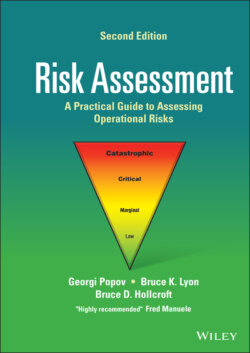Читать книгу Risk Assessment - Georgi Popov - Страница 34
2.4 OSHA Compliance and Risk Assessments
ОглавлениеIn the United States, the OSHA is the safety compliance standard minimum for employers. In 1970, the Occupational Safety and Health Act (OSH Act) was formed, making employers responsible for providing a safe and healthful workplace. OSHA’s stated mission is to assure safe and healthful workplaces by setting and enforcing standards, and by providing training, outreach, education, and assistance. The following description is provided by the OSHA website:
The OSH Act covers most private sector employers and their workers, in addition to some public sector employers and workers in the 50 states and certain territories and jurisdictions under federal authority. OSHA covers most private sector employers and their workers in all 50 states, the District of Columbia, and other U.S. jurisdictions either directly through Federal OSHA or through an OSHA‐approved state program. Workers at state and local government agencies are not covered by Federal OSHA, but have OSH Act protections if they work in those states that have an OSHA‐approved state program. Four additional states and one U.S. territory have OSHA‐approved plans that cover public sector workers only. State‐run health and safety programs must be at least as effective as the Federal OSHA program. OSHA standards are rules that describe the methods that employers must use to protect their employees from hazards.
There are OSHA standards for Construction work, Maritime operations, Agriculture, and General Industry, which is the set that applies to most worksites.
Employers must also comply with the General Duty Clause of the OSH Act, which requires employers to keep their workplace free of serious recognized hazards. This clause is generally cited when no OSHA standard applies to the hazard.
Before OSHA can issue a standard, it must go through an extensive and lengthy process that includes substantial public engagement, notice, and comment periods. This is known as OSHA's “rulemaking process.” According to the “OSHA Rulemaking Process” flowchart, the process begins with an identified health or safety hazard, and includes hazard analyses and risk assessments. In fact, many of the standards are in direct response to a serious accident or large loss such as the 1910.119, Process Safety Management of Highly Hazardous Chemicals standard and the Union Carbine Bhopal methylisocyanate (MIC) gas release tragedy of 1984.
